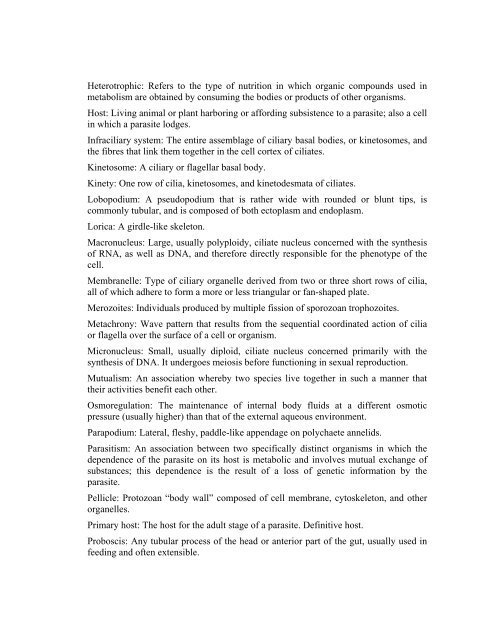ANIMAL DIVERSITY – I (NON-CHORDATES)
ANIMAL DIVERSITY – I (NON-CHORDATES)
ANIMAL DIVERSITY – I (NON-CHORDATES)
You also want an ePaper? Increase the reach of your titles
YUMPU automatically turns print PDFs into web optimized ePapers that Google loves.
Heterotrophic: Refers to the type of nutrition in which organic compounds used in<br />
metabolism are obtained by consuming the bodies or products of other organisms.<br />
Host: Living animal or plant harboring or affording subsistence to a parasite; also a cell<br />
in which a parasite lodges.<br />
Infraciliary system: The entire assemblage of ciliary basal bodies, or kinetosomes, and<br />
the fibres that link them together in the cell cortex of ciliates.<br />
Kinetosome: A ciliary or flagellar basal body.<br />
Kinety: One row of cilia, kinetosomes, and kinetodesmata of ciliates.<br />
Lobopodium: A pseudopodium that is rather wide with rounded or blunt tips, is<br />
commonly tubular, and is composed of both ectoplasm and endoplasm.<br />
Lorica: A girdle-like skeleton.<br />
Macronucleus: Large, usually polyploidy, ciliate nucleus concerned with the synthesis<br />
of RNA, as well as DNA, and therefore directly responsible for the phenotype of the<br />
cell.<br />
Membranelle: Type of ciliary organelle derived from two or three short rows of cilia,<br />
all of which adhere to form a more or less triangular or fan-shaped plate.<br />
Merozoites: Individuals produced by multiple fission of sporozoan trophozoites.<br />
Metachrony: Wave pattern that results from the sequential coordinated action of cilia<br />
or flagella over the surface of a cell or organism.<br />
Micronucleus: Small, usually diploid, ciliate nucleus concerned primarily with the<br />
synthesis of DNA. It undergoes meiosis before functioning in sexual reproduction.<br />
Mutualism: An association whereby two species live together in such a manner that<br />
their activities benefit each other.<br />
Osmoregulation: The maintenance of internal body fluids at a different osmotic<br />
pressure (usually higher) than that of the external aqueous environment.<br />
Parapodium: Lateral, fleshy, paddle-like appendage on polychaete annelids.<br />
Parasitism: An association between two specifically distinct organisms in which the<br />
dependence of the parasite on its host is metabolic and involves mutual exchange of<br />
substances; this dependence is the result of a loss of genetic information by the<br />
parasite.<br />
Pellicle: Protozoan “body wall” composed of cell membrane, cytoskeleton, and other<br />
organelles.<br />
Primary host: The host for the adult stage of a parasite. Definitive host.<br />
Proboscis: Any tubular process of the head or anterior part of the gut, usually used in<br />
feeding and often extensible.
















